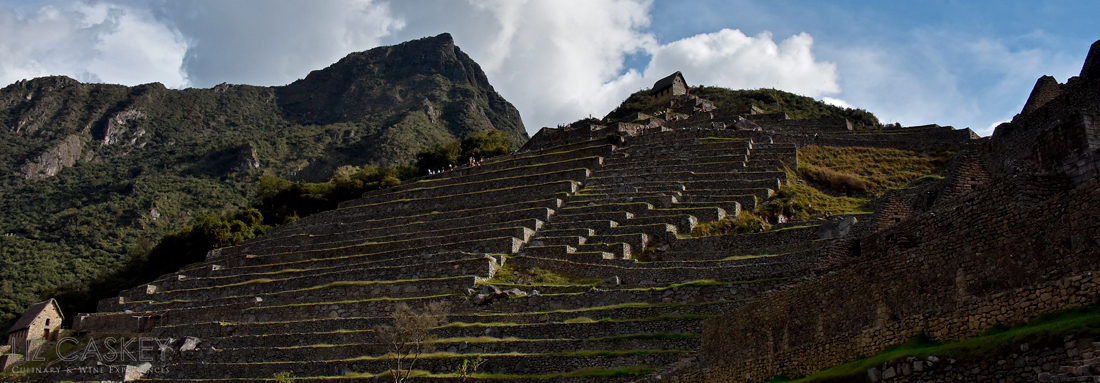
“En cinco, cuatro, tres, dos, uno, vamos con Liz!”. The lights flash on and the cameras swivel around to lock their focus on me in the studio kitchen. Here we go. We are broadcasting live; cooking for all of Chile for the next five to ten minutes. In those brief moments, I become a magician in the kitchen using my bag of tricks to explain the ingredients, preparation techniques, flavor combinations, and presentation tips, while trying to not lose a beat with the fast-paced chit chat of the hosts. Did I mention this is all in Spanish? It all happens so fast that I feel like I am in some veritable cooking time warp making the jump to light speed. Boom, I plate the recipe, one final zoom-in, and the camera cuts to commercials. I can breathe now. Welcome to my weekly cooking segment on one of Chile’s national morning shows.
Most of what I refer to as my career today, that is, being the owner of Liz Caskey, Inc., a culinary and wine tour business; a food and wine writer; a Sommelier school student; and a TV chef on Chilean national television, is a far cry from any previous job description I may have had—or even considered applying for. Tack on the fact that I am doing this all in Chile, the farthest possible end of the American continent, and it seems fairly understandable that I frequently get asked, “How (on earth) did you end up there?”
My life seemed to be following a relatively traditional career path, investment banking in New York, for my first year out of school. At the beginning, my future in the industry seemed bright enough that I was doing mini-calculations of when I could apply for my MBA. However, the honeymoon quickly evaporated with the never-ending 80-hour work weeks and high travel lifestyle. I was tired, bored, and restless. I had even lost my desire to cook (coupled with a minuscule Manhattan apartment kitchen), my lifetime hobby and passion since birth. On a red-eye flight back to New York from Mexico City, after a particularly grueling business trip, I realized that I had to do something immediately or risk watching my life pass by from the 38th floor of my bank’s office building. So I resigned. I needed to rethink my general direction. But destiny ironically intervened several weeks later when a similar banking job offer turned up in my e-mail in-box. However, this time the position was based in Santiago, Chile. I accepted it. Not because of the job itself, but because I subconsciously knew that this was my big chance to change my life.
My arrival in Santiago is not as arbitrary as it may sound. I did know what I was getting into before I got on the plane this time. I had spent my junior year abroad in Santiago and fallen in love with it: the Spanish, the stunning geography, the laid-back lifestyle, the Mediterranean climate, the general seductive nature of all of South America. Santiago is one of South America’s most sophisticated and modern cities, a thriving metropolis home to 5 million people with spectacular location at the foot of the snow capped Andes. So back in Chile after a 3-year hiatus, I could hardly believe how things had changed.
The infrastructure was rapidly modernizing; the economy was booming; and by my measure of things, there was a tangible food scene. At first, I was skeptical because the memories of my homesickness issues during my year abroad, all food-related, still lingered. That year of no authentic Thai, Chinese, Italian, Indian, and Mexican restaurants or ingredients, and Nescafé instant coffee (what Chileans consider “coffee”), left me constantly awaiting culinary care packages filled with dark chocolate, exotic spices, mole, and my other food staples. Now, confronted with a cornucopia of new restaurants, chichi supermarkets, ethnic stores, and invitations to events, I plunged stomach-first into this new gastronomic vision of Santiago.
While some things had significantly improved, I still found the food at many events and restaurants to be lackluster. One thing though was grabbing my attention: the ingredients. They were, in a word, glorious. Fresh native fish and shellfish brought in every morning from the Pacific Coast; a Technicolor of seasonal vegetables and fruits at my local farmers market; herbaceous, green local extra-virgin olive oils; spicy, artesian cold-smoked Chorizo; soft cow’s milk cheeses from the southern lakes region of Chile; and finally, new exotic food shops, from Asian to Middle Eastern, opened by newly arrived immigrants offering those hard-to-find spices and condiments.
My love of cooking rapidly returned. Every free weekend, I followed my nose to the market and later dug my hands into the prizes I took home. At first I cooked dinners for my friends, but the dinners soon became parties, and the parties led to recommendations for some informal (but paid) catering. After several months of this, I quit my day job and started my own catering business. Catering was my formal “path” into the food business, but I quickly saw that the Chilean wine industry and tourism were charging full force ahead. I sensed that there were a lot opportunities to be created, all that was needed was an entrepreneurial spark and a lot of gumption. With my catering business faring well, I set out on a concept that I thought could work in Chile: culinary tourism.
The idea for a culinary tour in Santiago was born when my mother came to visit me in the fall after moving back to Chile. I had recently moved downtown to a hip loft in a remodeled turn-of-the-century building in Barrio Brazil/Yungay, a trendy neighborhood going through gentrification. It was a very different area of the city; in fact, at times I wasn’t sure I was in Santiago. I wandered its labyrinth of tiny, cobblestone streets and plazas, admiring the European facades dating back a century; the quaint almacenes on the every corner; the daily open-air farmers markets in its streets; the stylish new cafés melding with the old schoperías (beer halls); and church bells always ringing. There was an air of another époque. Daily life was played out in the streets. Generations of neighbors knew each other. I was later told, by an older Chilean friend, that this is what is known as vida de barrio (neighborhood life), and Barrio Brazil is one of the few areas of the city that has preserved this unique flavor. Much of Santiago seems to be enamored with importing American-style suburbia.
During my mother’s visit, I showed her around the neighborhood as I normally went about my daily business: shopping in the farmers market, dropping off laundry with Señora Mónica, buying fresh cheese from the cheese shop, taking the metro into the civic center to pay bills, etc. One evening, after shopping for produce in morning and preparing a delicious dinner together, with a glass of wine in hand, she said, “Honey, I think this would be a really interesting culinary tour for visitors to Santiago. They can see the neighborhood, shop at the market with you, and prepare a meal back with the ingredients back at your loft. You know, your local take on Santiago.” My mind was already spinning with ideas. I had done a tour like this in Oaxaca, Mexico the year before, and it was one of the highlights of my trip there. This was the angle I had been looking for to get the culinary tour idea off the ground.
And the culinary tour took off. The final product did not stray too far from the original idea. With a lot of hard work, marketing, and PR, it has now become a unique and highly-regarded product in the food and tourism industries in both Santiago and all of Chile. Most importantly, it created the foundation for my current business: food and wine tours outside of Santiago in different wine valleys and Mendoza, Argentina. On a larger scale, it finally helped me to define the general direction of my life and career. Loving what I do has fundamentally changed my outlook on life. I found a path that has let me explore my passions and continually expand myself professionally and personally like I never had imagined. My success has not been entirely without heartaches or setbacks; I have definitely had my fair share. However, the most important lesson I have learned is that to achieve great success and happiness that risk is almost always inherent. I mean really, what did I have to loose?












